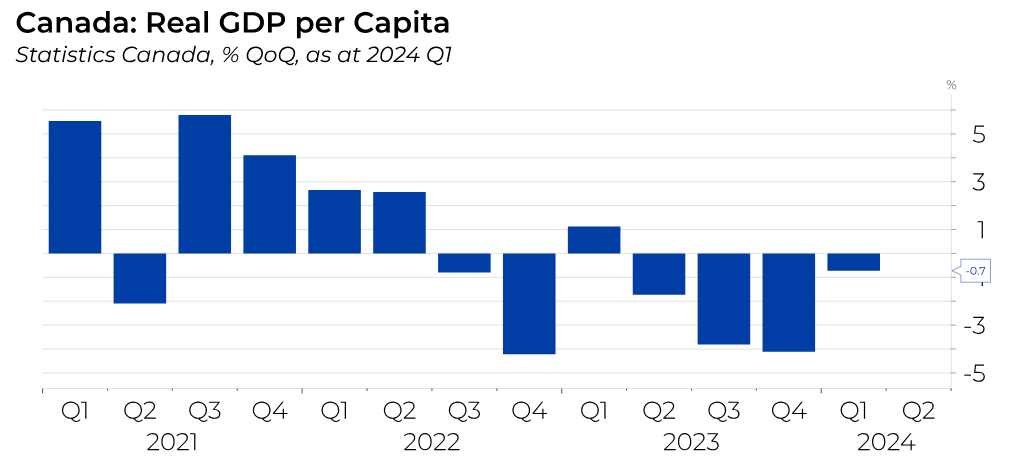The Bank of Canada recently announced a quarter-percentage-point reduction in its key interest rate, now set at 4.75%, marking its first cut in over four years. This decision has sparked optimism among real estate market analysts, suggesting that it could motivate hesitant homebuyers to enter the market, potentially rejuvenating the sector which has seen fluctuating dynamics over the past few years.
This rate cut comes amidst an influx of property listings in Canada’s major cities. Notably, in the Greater Toronto Area (GTA), new listings surged by 21.1% year-over-year in June, totaling 18,612 properties. Despite this increase, home sales have not kept pace, with a notable decline of 21.7% in May compared to the same period last year. The Toronto Regional Real Estate Board (TRREB) reported 7,013 home sales last month, down from 8,960 in May 2023, reflecting a significant cooling in buyer activity.
TRREB President Jennifer Pearce highlighted that prospective homebuyers have been awaiting clear signs of falling mortgage rates before committing to purchases. As borrowing costs decrease over the next 18 months, more buyers, particularly first-time buyers, are expected to enter the market. This anticipated influx could alleviate pressure in the currently tight rental market, offering more stability and options for both renters and potential homeowners.
A survey conducted by Leger for Royal LePage earlier this year revealed that 56% of Canadian adults active in the housing market had postponed their property searches due to rising interest rates since March 2022. Among those waiting, over half expressed a willingness to resume their search if interest rates decreased, with 10% indicating that a 25-basis-point drop would be sufficient to re-enter the market.
Royal LePage’s Chief Operating Officer, Karen Yolevski, acknowledged the pent-up demand and noted that typically, when rates decrease, prices tend to rise. She emphasized that the market rebound would not be immediate but gradual, as many potential buyers are waiting for further rate cuts before making a move. The Leger survey found that over 40% of prospective homebuyers are looking for a cut of at least 50 to 100 basis points before resuming their search, reflecting a cautious yet optimistic outlook among market participants.
In the GTA, the average selling price of a home decreased by 2.5% year-over-year, standing at $1,165,691 last month. Sales in the City of Toronto dropped by 17.3%, while sales throughout the rest of the GTA fell by 24.3%. All property types experienced a decline in sales, with townhouses and condos leading the drop at 24.3% and 24.1%, respectively, followed by semi-detached homes at 21.3% and detached properties at 19.4%.
Yolevski cautioned that the market recovery would be slow, noting that buyers are more concerned with monthly carrying costs rather than the sale price. Lower interest rates are expected to gradually reduce these costs, easing the burden on homebuyers, especially first-time buyers. This perspective is crucial as it highlights the importance of affordability in monthly payments, which often dictates buyer decisions more than the overall property price.
TD Bank’s Senior Economist, James Orlando, predicted a cautious approach to future rate cuts by the central bank, emphasizing the need to avoid reigniting inflationary pressures and the housing market prematurely. He anticipated a “cut-pause-cut” path, with the next rate cut likely occurring in September. This strategy is intended to balance the objectives of stimulating the economy while preventing an overheated housing market, which could lead to unsustainable price increases and economic instability.
For homeowners with variable-rate mortgages, this decision is welcome news. Ratesdotca’s mortgage and real estate specialist, Victor Tran, estimated that each 25-basis-point decrease would reduce payments by $15 per $100,000 of mortgage. This rate cut could ease the financial strain on homeowners facing significant payment increases upon renewal, as noted in the Bank of Canada’s annual Financial Stability Report. The report highlighted the challenges faced by variable-rate mortgage holders, who are experiencing up to a 60% increase in monthly payments.
As the Bank of Canada spreads rate decreases over the coming months, mortgage holders may increasingly consider variable rates to capitalize on the downturn, despite the significant spread between fixed and variable rates. This strategic decision by the central bank aims to balance easing financial burdens while maintaining economic stability.
The broader implications of this rate cut extend beyond immediate homebuyer activity. It could signal a shift in the economic landscape, encouraging increased consumer spending and investment. With lower borrowing costs, businesses may also find it more feasible to expand, potentially leading to job creation and economic growth. However, this positive outlook is tempered by the need for caution to prevent inflation from rebounding, ensuring that the economic recovery is sustainable in the long term.
Overall, the Bank of Canada’s recent interest rate cut marks a significant moment for the real estate market and the broader economy. As potential homebuyers weigh their options, the gradual easing of borrowing costs is expected to bring more stability and activity to the housing market, benefiting both buyers and sellers in the coming months.














